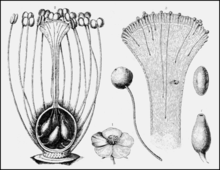Chemotropism
This article needs additional citations for verification. (November 2015) |
Chemotropism is defined as the growth of organisms navigated by chemical
Chemotropism is slightly different from Chemotaxis, the major difference being that chemotropism is related to growth, while chemotaxis is related to locomotion. A chemotropic process may have an underlying chemotactic component, as is the case with mating yeast.[3]
Chemotropism in plants

One prime example of chemotropism is seen in plant fertilization and pollen tube elongation of angiosperms, flowering plants.[4] Unlike animals, plants cannot move, and therefore need a delivery mechanism for sexual reproduction. Pollen, which contains the male gametophyte is transferred to another plant via insects or wind.[5] If the pollen is compatible it will germinate and begin to grow.[5] The ovary releases chemicals that stimulates a positive chemotropic response from the developing pollen tube.[6] In response the tube develops a defined tip growth area that promotes directional growth and elongation of the pollen tube due to a calcium gradient.[5] The steep calcium gradient is localized in the tip and promotes elongation and orientation of the growth.[5] This calcium gradient is essential for the growth to occur; it has been shown that inhibiting the formation of the gradient results in no growth.[5] As the pollen tube continues to grow towards the ovules, the male sperm remains in the apical region and is transported to the female ovule.[7] The pollen tube elongates at a rate comparable to neurite development
An example of positive and negative chemotropism is shown by a plant's roots; the roots grow towards useful
Chemotropism in animals
In more complex organisms an example of chemotropic movement includes the growth of individual neuronal cell
Chemotropism in Fungi

Fungal chemotropism was first reported over 100 years ago by Anton de Bary.[13] One example of fungi using chemotropism is seen in Yeast.Yeast release chemical pheromones in order to attract mates.[14] Each haploid yeast cells express specific haploid genes; haploid α-cells express α-genes and haploid a-cells express a-genes.[15] Each cell type releases a unique pheromone: a- or α-factor.[16] By secreting these factors a chemical gradient is formed that attracts the other type of yeast cell during mating. In order for the yeast to sense the gradient they have to have proper receptors that bind a- or α-factor: Ste3 and Ste2 respectively.[17] The receptors to detect the pheromones are seven transmembrane G-protein coupled receptor (GPCR).[16] Once activated, there is a signaling cascade that results in the activation of transcription factors for mating-specific genes such as those involved in cell cycle arrest, directional polarization towards the chemical gradient, and sexual hyphae formation.[13][17] When fungal hyphae touch, the cells merge to form a diploid zygote.[17] Mating pairs of budding yeast cells may polarize away from each other, but are able to adjust the location of polarity to enable successful alignment and fusion.[3]
See also
References
- S2CID 4449720.
- ^ "Chemotropism Definition and Examples - Biology Online Dictionary". Biology Articles, Tutorials & Dictionary Online. 2019-10-07. Retrieved 2020-03-23.
- ^ S2CID 235242389.
- ^ "Pollen Tube: Growth, Function & Formation - Video & Lesson Transcript". Study.com. Retrieved 2020-04-18.
- ^ PMID 17214979.
- S2CID 4592052. Retrieved 7 February 2018.
- PMID 11687487.
- S2CID 17630453.
- S2CID 84789317.
- ^ S2CID 7449327.
- S2CID 4247407.)
{{cite journal}}: CS1 maint: multiple names: authors list (link - PMID 7649810.
- ^ PMID 27150623.
- PMID 31152053.
- ^ Lodish, Harvey; Berk, Arnoldaa; Zipursky, S. Lawrence; Matsudaira, Paul; Baltimore, David; Darnell, James (2000). "Cell-Type Specification and Mating-Type Conversion in Yeast". Molecular Cell Biology. 4th Edition.
- ^ PMID 20066086.
- ^ PMID 23466674.
